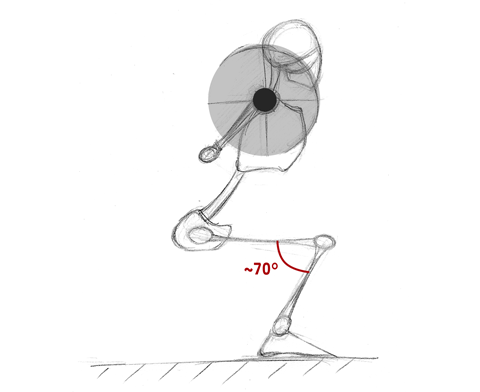
The squat is a weight training exercise, and one of three movements in powerlifting. From the standing position, it consists of a flexion and extension of the hips, knees and ankles. Depending on the modalities of the exercise, the needs and possibilities of the athlete, the depth of the squat, and therefore the angle thigh - leg will vary from 90 to 70 degrees, or even less in deep squat (Fig. 1). The squat is largely used in strength and conditioning. Indeed, it is one of the most studied exercises and it shows a strong performance transfer potential with many activities.
During the squat, a stretch-shortening cycle is observed. Usually, this results in higher peak force, velocity and power output. During the eccentric phase (the descent) of the squat, the knee extensors are stretched. If this stretch occurs in a rapid fashion, it will allow a storage of potential elastic energy (for a small explanation on the elastic potential energy, click here) and in an activation of a stretch reflex. If the concentric phase (the ascent) happens immediately after the eccentric phase, the elastic energy will be released. This means that this elastic energy participates in the positive work done by the muscle during its shortening. In less technical terms, a muscle that contracts immediately after stretching improves its contraction performance. This is the case, for example, during a countermovement jump. But what happened in squat when the stretch-shortening cycle is removed as this is the case in the box squat variant ?
To answer this question, an American research team Appalachian State University studied the influence of the stretch-shortening cycle in different squat variants. These researchers were interested in the differences that could exist between a squat and a squat box. The box squat takes place in the same way as a traditional squat except that the practitioner must sit on a box (hence its name) for a few seconds, and only after this break, he can perform the concentric phase (Fig. 2). The break on the box is supposed to remove the stretch-shortening cycle.

Figure 1. Vue sagittale de l'athlète en position de développé couché.

Figure 2. Trajectoire de la barre dans le plan sagittal (Du point A vers le point C).
The tests were carried out on a sample of 8 men, all competitors in powerlifting with an average 1RM in squat of 200,11 ± 58,91 kg. The subjects performed squat and squat box with 3 different loads that corresponded to 60, 70 and 80% of 1RM. All squats were performed to a 70 degrees knee angle (Fig. 1). During the box squat, the pause on the box was 1 second.
To analyze the differences between the two movements, peak force and power during the concentric phase were compared. In addition, muscle activity of vastus lateralis, vastus medialis, biceps femoris and longissimus were analyzed using electromyography (EMG).
The researchers observed very few significant differences between the two exercises in force, power, and surface EMG. With a load equivalent to 70% 1RM, the maximum force developed was greater during the Box Squat. And with a load equivalent to 80% 1RM, the power produced was greater in the box squat. Concerning the EMG level, the activity of the biceps femoris was greater during the squat at 60% 1RM. And at 70% 1RM, the activity of the vastus lateralis was greater during the squat.
These results are quite surprising. From a kinetic point of view, the two exercises seem similar. The hypothesis was that the box squat will show lower performance in force and power since the stretch-shortening cycle was removed with the pause on the box. The researchers put forward two hypotheses:
This study shows that there is little difference in muscle activity between the two exercises. Although this study does not show any kinetic differences between the squat and the squat box, the squat box can be beneficial on several points:
The box squat appears as an additional exercise that can be useful for a specific job.
We remind you that you can quote articles by limiting your quotation to 200 words maximum and you must include a nominative link to this one. Any other use, especially copying in full on forum, website or any other content, is strictly prohibited. In doubt, contact us.
Copyright © 2011-2024 - www.sci-sport.com - All rights reserved